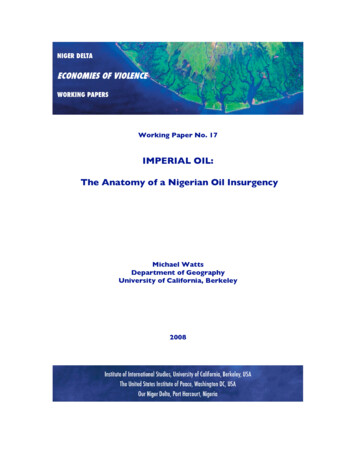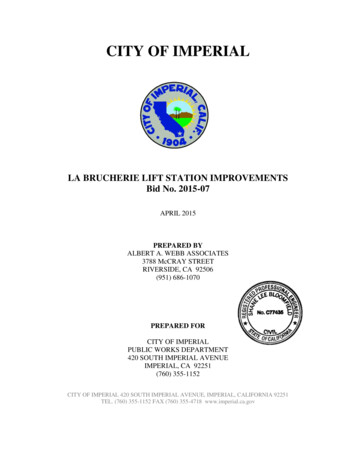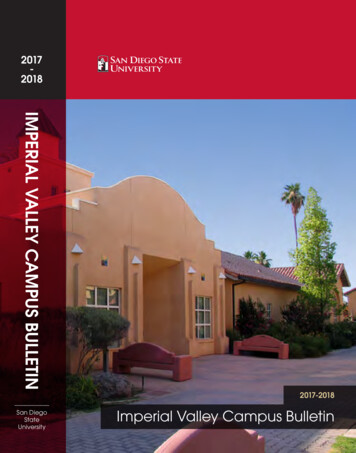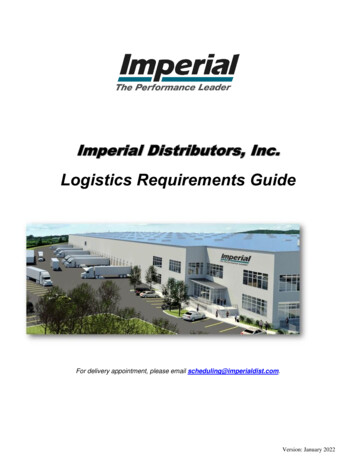
Transcription
Working Paper No. 17IMPERIAL OIL:The Anatomy of a Nigerian Oil InsurgencyMichael WattsDepartment of GeographyUniversity of California, Berkeley2008
IMPERIAL OIL:The Anatomy of a Nigerian Oil InsurgencyMichael Watts1Blood may be thicker than water, but oil is thicker than both,- Perry Anderson, New Left Review, 10, 2001, p.30.In his 2006 State of the Union address, George Bush finally put into words what allprevious Presidents could not bring themselves to utter in public. Addiction. The US,he conceded, is “addicted” to oil – which is to say addicted to the car – and as aconsequence unhealthily dependent upon Middle East suppliers. What he neglected tomention was that the post-WWII US “global oil acquisition strategy” as Michael Klare(2004) calls it – a central plank of US foreign policy since President Roosevelt met KingSaud of Saudi Arabia and cobbled together their ‘special relationship’ aboard the USSQuincy in February 1945 – is in a total shambles. The pillars of that policy – Iran, SaudiArabia and the Gulf oil states, and Venezuela – are hardly supplicant sheep within the USimperial fold. Fifty years of a special relationship with the Saud family, after all, broughtSeptember 11th.With surplus capacity in OPEC at an all time low and speculation running rampant in thecommodity exchanges, Big Oil conversely is awash with money. Corporate profits arehistorically unprecedented. Chevron netted a cool 14 billion in 2005, and first quarterearnings in 2006 are 50% higher than the previous year, an historic high obscene enoughto have Congress muttering about a windfall profits tax. So-called ‘supply risks’ in Iran,Venezuela and Nigeria coupled with the speculative impulses of the oil traders havedriven up the price of oil to around 70 a barrel, and a former oil-man (surrounded by aposse of other former oil men) stalk the halls of the White House. As if that were notenough, the New York Times (March 27th 2006, p.1) reports that through a ‘vague law’the US government will waive, for the oil supermajors, about 7 billion in state royaltiesover the next seven years. All of this, as Toby Shelley (2005) reminds us in his new bookOil, takes us back to the 1973 oil embargo and President Nixon’s Project Independencedesigned to achieve US self sufficiency by 1980 (for the record US dependency uponimported oil in the late 1960’s was 20% and is expected to be about 66% by 2025). Thepolicy failed miserably, and Nixon resorted to maximizing domestic supply and turningto reliable foreign suppliers at minimal cost - just as George Bush intends to do (Oil,p.117).1Director of the Centre for African Studies, University of California, Berkeley. This is a version of a talkdelivered at the Institute of Geography, University of Bonn, July 9th 2006. I am grateful for the hospitalityof my friend Hans-Georg Bohle and the assistance provided by Dorothea Kleine.
It is no surprise, then, that alternative sources of oil-supply should be very much on theBush radar screen (since conservation strategies or increased gas taxes areconspicuously absent). Cheney’s National Energy Strategy Report in 2001 bemoaned USoil habit – “a dependency on foreign powers that do not have America’s interests atheart” - long before the State of the Union address. A recent report in the FinancialTimes headline (March 1st 2006) makes the new agenda crystal clear. If Africa is not aswell endowed in hydrocarbons (both oil and gas) as the Gulf states, nevertheless thecontinent “is all set to balance power”, and as a consequence is “the subject of fiercecompetition by energy companies” (ibid., p.1). IHS Energy – one of the oil industry’smajor consulting companies – expects African oil production, especially along theAtlantic littoral, to attract “huge exploration investment” contributing over 30% ofworld liquid hydrocarbon production by 2010. Over the last five years when new oilfield discoveries were a scarce commodity, Africa contributed one in every four barrelsof new petroleum discovered outside of Northern America. As the Catholic ReliefServices put it in their exemplary study of oil geopolitics, The Bottom of the Barrel, (Garyand Karl 2003), a new scramble is in the making. The battleground consists of the richAfrican oilfields – the continent’s “ copious reserves of natural gas and its sweet lightoil” (ibid., p.1).Energy security is the name of the game. No surprise, then, that the Council of ForeignRelation’s call for a different US approach to Africa in its new report More thanHumanitarianism (2005), turns on Africa’s “growing strategic importance” for US policy(p.xiv). It is the West African Gulf of Guinea, encompassing the rich on and off shorefields stretching from Nigeria to Angola, that represents a key plank in Bush’s alternativeto the increasingly volatile and unpredictable oil-states of the Persian Gulf. Nigeria andAngola alone account for nearly 4 million bpd (almost half of Africa’s output) and US oilcompanies alone have invested more than 40 billion in the region over the last decade(and another 30 billion expected between 2005 and 2010). Oil investment nowrepresents over 50% of all foreign direct investment in the continent (and over 60% ofall FDI in the top four FDI recipient countries) and almost 90% of all cross-bordermergers and acquisition activity since 2003 has been in the mining and petroleum sector(WIR 2005, 43). Strategic interest for the US certainly means cheap and reliable lowsulphur (‘sweet’) oil imports but also keeping the Chinese (for example, in Sudan) andSouth Koreans (for example, in Nigeria) – aggressive new actors in the African oilbusiness – and Islamic terror at bay (Africa is, according to the intelligence community,the ‘new frontier’ in the fight against revolutionary Islam).In short, the Nigerian, and the wider Gulf of Guinea oil complex draws its particularspecificity in the contemporary moment not simply from the volatility of world oilmarkets and the failure of the US global oil acquisition strategy of the post war periodbut from the additional ingredient of Global war on terror (GWOT). In the face ofsupport by neoconservative promoters and opportunistic Washington lobbyists,strategists at the Pentagon have invented a new security threat to increase funding forEuropean Command (EUCOM’s) footprint in Africa (Lubeck, Watts and Lipschitz 2007).Recently, Deputy Assistant Secretary of Defense for African Affairs Teresa Whelanannounced the discovery of a “new threat paradigm”—the threat of “ungovernedspaces”---inNorthwestandWestAfrica
elan). In practice all four of themilitary services – including an Africa Clearing House on security information,supported by a Pentagon think-tank, the Africa Center for Strategic Studies housed atthe National Defense University - are involved and implicated in the new scramble forthe continent. Against a backdrop of spiraling militancy across the Delta, US interestshave met up with European strategic concerns in the Gulf in the establishment of the“Gulf of Guinea Energy Security Strategy” (GGESS). By December, 2005 the Americanambassador and the Managing Director of Nigerian National Petroleum Corporation(NNPC) agreed “to establish four special committees to co-ordinate action againsttrafficking in small arms in the Niger Delta, bolster maritime and coastal security in theregion, promote community development and poverty reduction, and combat moneylaundering and other financial crimes” (This Day December 9th 2005).Theestablishment of a new African command (AFRICOM) in 2007 is the final capstone inthe militarization of American energy security policy in Africa. Energy security, it turnsout, is a terrifying hybrid, a perplexing doubleness, containing the old and the new:primitive accumulation and American militarism coupled to the war on terror (Harvey2003; RETORT 2005; Barnes 2005).This perfect storm of forces linking dispossession, war and energy provides the broadcontext in which one can grasp the descent into violence and ungovernability that hascharacterised the political dynamics of the Nigerian oilfields, arguably one of the moststrategic centres of oil supply for the United States in the post 9/11 world of energysecurity (ICG 2006). It is the broad dynamics of what is in effect now an insurgency inthe oil-producing Niger delta that I shall address here. The simultaneous growth ofmilitancy and oil disruption commenced in the late 1990s. By 2003 oil supply had beencompromised by 750,000 barrels per day as a result of militant attacks on oilinstallations across the region. In April 2004, another wave of violence erupted aroundoil installations - at the end of April, Shell lost production of up to 370,000 barrels perday, largely in the western Delta - this time amid the presence of armed insurgencies.Two so-called ‘ethnic militia’ led by Ateke Tom (of the Niger Delta Vigilante) and AlhajiAsari Dokubo (of the Niger Delta People’s Volunteer Force), each driven and partlyfunded by oil monies and actively deployed (and paid) by high ranking politicians aspolitical thugs during the 2003 elections, have transformed the operating environment inthe Niger delta oilfields. Since late 2005, the situation in the Delta has only worsened(Figure 1). Following attacks on oil installations and the taking of hostages in lateDecember 2005 and early 2006, a hitherto unknown group of insurgents from theWarri region, the Movement for the Emancipation of the Niger Delta (MEND) begancalling for the international community to evacuate from the Niger Delta by February12th, or “face violent attacks.” Two weeks later, the group claimed responsibility forattacking a Federal naval vessel and for the kidnapping of nine workers employed by theoil servicing company Willbros, allegedly in retaliation for an attack by the Nigerianmilitary on a community in the Western Delta. More than fifteen Nigerian soldiers werekilled and between May and August 2006 there were at least three kidnappings per
month in the first half of 2006 (typically the hostages have all been released following thepayment of substantial ransoms by the government).2 In the last nine months theFigure 1Oil Loss in the Niger Delta: 1998-2006Average Annual Crude Oil Production Deferred in Nigeria 1999 2006700,000600,000Barrels per 120022003200420052006YearSource: www.legaloil.com 2007escalation of attacks – including electronically detonated car bombings, attacks ongovernment buildings, and massive disruption of oil installations deploying sophisticatedmilitary equipment, and the kidnapping of workers sometimes from platforms 40-60kmsoff shore – have spiraled out of control. In a deteriorating environment in which manyoil companies have withdrawn personnel and cut back production – currently (May2007) there is a 900,000 barrel per day shut in - Julius Berger, the largest construction2The companies and government have typically denied the payments of ransoms to militants but therehave been reports in the press, by activists and others of payments in excess of 250,000. In fact thedecline in oil bunkering since 2004 has seen militias turning to kidnapping and extortion as sources ofrevenues as bunkering income has fallen.
company operating in the country, announced its withdrawal from the Niger Delta inthe middle of 2006. President Obasanjo has sent in additional troops to bolster the JointMilitary Task Force (JMTF) in the Delta but it is clear that that are incapable of operatingeffectively within the riverine creeks. The violence has continued – indeed deepened; atleast 60 militants were reported killed and another 100 arrested in two days of brutalfighting in Bayelsa State late August 2006. According to the Centre for Strategic andinternational Studies (CSIS 2007) 123 expatriate hostages have been taken since January2006 (until early March 2007) and there have been 42 attacks on oil installations overthe same period. As I write, the residence of the new Vice-President elect (theGovernor of Bayelsa State) has been bombed, Chevron has temporarily shut down itsoperations, and following a massive pipeline explosion at Bomu at total of 900,000barrels of oil per day are currently shut in (30% of official production). It is quiteunclear, when located on this larger canvas, what Petroleum Minister Edmund Daukorucould possibly have meant when he announced to OPEC in February 2007 in Greecethat “the worst is over”, that “it is a very, very temporary thing” (United PressInternational January 28th 2007,http://www.upi.com/Energy/analysis nigeria hopeful for oil future).The costs of the oil insurgency are vast. A report prepared for the Nigerian NationalPetroleum Company (NNPC) published in 2003 entitled Back from the Brink paints avery gloomy “risk audit” for the Delta. NNPC estimated that between 1998 and 2003,there were four hundred “vandalizations” on company facilities each year (and 581between January and September 2004); oil losses amounted to over 1 billion annually.In early 2006 MEND claimed a goal of cutting Nigerian output by 30% and hasapparently succeeded. Within the first six months of 2006, there were nineteen attackson foreign oil operations and over 2.187 billion lost in oil revenues; the Department ofPetroleum Resources claims this figure represents 32% of the revenue the countrygenerated this year (Figure 2). The Nigerian government claims that between 1999 andINSERTFigure 2Niger Delta Oil Disruptions 2006Source: National Geographic, January 20072005 oil losses amounted to 6.8 billion but in November 2006 the managing directorof Shell Nigeria reported that the loss of revenues due to ‘unrest and violence’ was 61million per day (a shut-in of about 800,000 barrels per day), amounting to a staggering 9 billion since January 2006. Against a backdrop of escalating attacks on oil facilities anda proliferation of kidnappings, the Joint Revolutionary Council (apparently an umbrellagroup for insurgents) threatened ‘black November’ as an “all out attack on oil operatingcompanies” (The Observer, November 5th 2006).The Road to Serfdom
The backdrop to the new scramble for oil is the calamity of African poverty – or todeploy the language of the Report of The Commission on Africa (2005) assembled by TonyBlair and Gordon Brown, “the greatest tragedy of our time”. 2005 was dubbed the‘Year of Africa’ but there was little to celebrate. Of course the Live 8 concerts drew a 2billion global audience, and a week later the G8 pledged to double aid to Africa ( 25billion by 2010) and forgive the debts of fourteen African states. But the desperate andterrifying conditions across much of the African continent had forced itself into theinternational limelight aided and abetted by a motley crew of humanitarians from Bonoto Jeffrey Sachs to the Pope. The Millennium Declaration in 2000, Bush’s MillenniumChallenge Account and the Emergency Plan for AIDS Relief (PEPFAR), the AfricanGrowth And Opportunity Act, and now the new World Bank African Action Plan, wecan now see, are the milestones in a deep crisis that is only weakly captured in debatesover growing global inequality. Collectively these palliatives were belated responses tothe unacceptable face of two decades and more of globalization, reform and the searchfor the Holy Grails of good governance and the neoliberal market (Elyachar 2005). Onthe continent itself, the New Economic Partnership for African Development [NEPAD](2001) and the revamped African Union (formerly the Organization for African Unity)offered the prospect that poor leadership - the pathologies of the African postcolonialstate variously described as patrimonialism, prebendalism, predation, quasi-statehood,the postcolony, politics of the belly - were to be taken seriously by an African politicalclass that purportedly represented a new sort of democratic dispensation unleashedby a raft of the political transitions during the 1990s.To see the African crisis, however, as a moral or ethical failure on the part of the‘international community’ - not least in its failure to meet the pledges promised to theUN to cut global poverty in half by 2015 (See the UN The Milleninium Goals Report2005) is only a partial truth. The real crisis of Africa is that after 25 years of brutalneoliberal reform, and savage World Bank structural adjustment and IMF stabilization,African development has failed catastrophically. William Easterly (2006), former highranking World Bank apparatchik, in his new lacerating demolition of structuraladjustment – “a quarter century of economic failure and political chaos” (cited on hiswebsite: http://www.nyu.edu/fas/institute/dri/Easterly/) - boldly states that the entireunaccountable enterprise of planned reform is “absurd”. It was Africa after all that wasthe testing ground for the Hayekian counter-revolution that swept throughdevelopment world in the 1970s. It began with the Berg report in 1980 which was thefirst systematic attempt to take the Chicago Boys experience in post-Allende Chile – onsome readings the birth of neo-liberalism (Harvey 2005) – and impose it on an entirecontinent. The ideas of Elliot Berg and his fellow travelers marked the triumph of along-march undertaken by the likes of Peter Bauer, H.G.Johnson, and Deepak Lal (ablysupported by the monetarist think tanks such as the Institute of Economic Affairs, theMont Pelerin Society and the astonishing rise to power from the early presence of LeoStrauss and Fredrich Hayek of the ‘Chicago School’) through development institutionslike the World Bank. Long before shock therapy in eastern Europe or even the debtdriven ‘adjustments’ in Latin America, it was sub Saharan Africa that was the playgroundfor neo-liberalism’s assault on the ‘over extended public sector’, ‘excessive physicalcapital formation’, and the ‘proliferation of market distortions’ (Toye, 1987, pp.48-49).
According to the UN, 26 of 32 sub-Saharan states had a ‘liberal’ economic regime by1998. If the 1980’s was Africa’s ‘Lost Decade’ – collapsing commodity prices,deteriorating terms of trade and the first crashing waves of IMF austerity - then howmight one characterize the last fifteen years - a long decade in which the benefits ofreform were to be finally felt - in which life expectancy across subs Saharan Africa hassteadily fallen and per capita income has at best stagnated? A ‘Lost Generation’? And allof this during a period in which net official ODA fell by 40% (from 18.7 to 10 billion).If it is lucky, Africa will achieve its Millennium Goals of universal primary education and a50% reduction in poverty by the middle of the next century (2150).In Africa, the court of neoliberalism has been concluded, and the verdict is in. And thepicture is not pretty. Over the last thirty years there has been no growth in income forthe average African. Life expectancy is 46 years. Twenty-three of 47 sub Saharan stateshave currently a GDP of less than 3 billion (Exxon-Mobil’s net profit in the first quarterof 2006 was 8 billion). By 2005, 38 of the top 59 priority countries that failed to makeheadway toward the Millennium Goals were sub Saharan states and according to the2005 Chronic Poverty Report, all 16 of the most “desperately derived” countries arelocated in sub-Saharan Africa. Over 300 million people live on less than 2 per day –and this is expected to rise to 400 million by 2015. One third of the population of thecontinent is undernourished (Benson 2004); stunting rates run at almost 40%.According to a UNFAO assessment in January 2006, 27 countries are in need ofemergency food relief.The neoliberal tsunami broke with particular ferocity of African cities, and the Africanslum world in particular. Reform – the privatization of public utilities creating massivecorporate profits and a decline in service provision, the slashing of urban services, theimmiseration of many sectors of the public workforce, the collapse of manufactures andreal wages, and often the disappearance of the middle class - was, as Mike Davis (2006)notes, remorselessly anti-urban in its effects. As a consequence, African citiesconfronted the horrifying realities of economic contraction of 2-5% per year andsustained population growth of up to 10% per annum (Zimbabwe’s urban labor marketgrew by 300,000 per year in the 1990s while urban employment grew by just 3% of thatfigure). In Dar es Salaam public service expenditures per capital fell by ten per cent yearin the 1980s; in Khartoum adjustment created 1 million ‘new poor’; urban poverty inNigeria almost tripled between 1980 and the mid 19990s. No wonder that 85% of urbangrowth in Nairobi, Kinshasha or Nouakchott in the 1980s and 1990s wasaccommodated in the slums barracks of sprawling and ungovernable cities. Everyone’sworst urban apocalypse (Packer 2006) – Lagos – grew from 300, 000 to 13 million inover fifty years but it will be part of a vast Gulf of Guinea slum expected toaccommodation 60 million poor along a littoral corridor 600 kms stretching from BeninCity to Accra by 2020. Black Africa will contain 332 million slum dwellers by 2015, afigure expected to double every fifteen years (Davis 2006, p.19). The pillaging andprivatization of the state – whatever its African ‘pathologies’ – and the African commonsis the most extraordinary spectacle of primitive accumulation by dispossession, all madein the name of foreign assistance (Harvey 2005). The involution of the African city hasas its corollary not an insurgent lumpenproletariat but as Davis himself laconically admitsthe rise of ‘Mohammed and the Holy Ghost’, a vast political universe of Islamism and
Pentecostalism. It is this occult world of invisible powers – whether populist Islam inKano or witchcraft in Soweto (Ashforth 2005) – that represents the most compellingideological legacy of neoliberal utopianism in Africa.As if to confirm the catastrophism of commentators like Robert Kaplan (‘the cominganarchy’) , the calamity that is African economic development ran straight into another:the HIV/AIDS epidemic. While new epidemiological data suggests that the prevalencerates and possible demographic and socio-economic impacts for much of Western andnortheastern Africa may have been exaggerated (Guardian, April 21st 2006, p.29), thepall that the disease has imposed on some regions is incontestable. The impact ofHIV/AIDS – with an 8% adult prevalence and 28 million infected, Africa accounts for 2.3million AIDS deaths per year – has transformed life expectancy in southern and easternAfrica. Twenty years ago, a male child could reasonably expect to live to 60 inBotswana; currently it is about 30. By 2010 there will be more than 50 million orphansin Africa.Of course, there are those within the development business for whom the failure ofsecular nationalist development is a result not of too much neoliberalism, but notenough. The complaint here, typically from those within the free-market establishment,is that adjustment and stabilization has never really been implemented (a right-wingversion of the left-wing claim that adjustment was asking African ruling classes tocommit political suicide). SAP’s were simply ‘vetriloquism’ in which, as van de Walle(cited in Easterly 2005, p.146) sees it, the IMF/IBRD had given up trying to get Africangovernments to do things but simply want to be told what governments might do to geta loan. There is, of course, some truth to this (but the cry of any planned failure willalways be “we were defeated by not going far enough”). David Harvey (2005) hasdescribed the radically uneven geographical patterns of neoliberal governance and rule.Yet he makes the point that within this complexity is a ‘universal tendency’ to increasesocial inequality and expose the poor top austerity and marginalization. And the realityis that Bank reforms, and the pressures imposed by the WTO from the mid 1990sonwards, in Africa did have drastic consequences for trade and investment – the litmustest of neoliberal development – seen in the widespread dismantling of state marketingboards and of trade protections. And here the picture is devastating. In absolute termsAfrican exports grew quite rapidly from 1963-2000, but at a much slower rate that forworld trade generally. Africa’s share of world exports fell from almost 6% in 1962 to2% in 2000. In non-oil products (food and manufactures) growth rates of exportsbetween 1980 and 1998 were miserable. Rodrik (1999) argues that given Africanconditions (income, geography, socioeconomic conditions), the performance is ‘average’.Yet it is incontestable that African exports are characterized overall by a “disintegrationfrom Northern markets” and “isolation from more dynamic developments in thecomposition of international trade” (Gibbon and Ponte, 2005, p.44). UNCTADshowed that of the exports from 26 African states, the average concentration onprimary exports has remained basically unchanged (roughly 85%) since 1980. In allcategories, sub Saharan Africa has failed to move up the value-added chain away fromprimary commodities.
The African accumulation crisis, and the dynamics of capital and trade flows, are inpractice complex and uneven (Hart 2003). In addition to oil (and the very few cases ofmanufacturing growth in places like Mauritius which are simple national exportprocessing zones), the other source of economic dynamism is the (uneven) emergenceof global value chains especially around high values agricultures (fresh fruits andvegetables) [Friedberg 2004, Gibbon and Ponte 2005] in South Africa, flowers in Kenya,green beans in Senegal, these forms of contract production, typically buyer-drivencommodity chains in which retailer exert enormous power have created islands ofagrarian capitalism but as Gibbon and Ponte show, they contribute to and deepenpatterns of existing inequality across Africa and rest on “concentrations of privateeconomic power” (p.160), which typically means non-African business elites. Thedeepening of commodification in the countryside – driven in part by the dismantling ofthe marketing boards under neoliberalism - in tandem with demographic pressures(caused as much by civil war and displacement as high fertility regimes), has made landstruggles and the dismantling of what remains of the African commons a vivid part of thenew landscape of African development (Peters 2004; Woodhouse, Bernstein and Hulme2000).In reality what is on offer is a bleak world of military neoliberalism. At one pole,enclaves of often militarily fortified accumulation (of which the oil complex is theparadigmatic case; see Ferguson 2006) and the violent, sometimes chaotic, markets sographically depicted in the powerful documentary film by Hubert Sauper Darwin’sNightmare. On the other are the black holes of recession, withdrawal and unevencommodification (Bernstein 2004). These complex trajectories of accumulation aredominated at this moment by the centrality of extraction and a return to primarycommodity production.The New African ‘Gulf States’One aspect of the doubleness that I referred to earlier is that on this bleak canvas ofdevelopment failure in Africa is the undisputed fact that currently the continent is thecentre of a major oil boom. To the extent there is any economic dynamism, in otherwords, it resides in the primary commodities sector which is the most important sourcecapitalist accumulation on the continent. Over the period 1981-1985, FDI inflow intoAfrica was running at 1.7 billion per annum; by 1991-1995 it had grown to 3.8 billion(Asiedu 2005; WIR 2005). Yet as a percentage of all developing country FDI inflow, thefigure represented a secular decline from 9% to less than 5% (all-in-all minisculecompared to South and East Asia and Latin America). Between 1995 and 2001, FDIinflow amounted to 7 billion per year but almost two thirds of the portfolio wasdestined for three countries (Angola, Nigeria and South Africa, in which oil FDIaccounted for 90% of all FDI inflow, see Figure 4). Half of Africa’s states had effectivelynone. Two thirds of FDI was derived from the same three countries (UK, Germanyand the US) that had dominated FDI supply in 1980. According to the WorldInvestment Report (2005), FDI into Africa is currently 18 billion; four countriesaccount for 50%, and the top ten almost three quarters. To put the matter starkly, thevast bulk of private transnational investment – the hallmark of success for the neoliberalproject - was monopolized by a quartet of mining-energy economies.
The continent accounts for roughly 10% of world oil output and 9.3% of knownreserves. Though oil fields in Africa are generally smaller and deeper than the MiddleEast - and production costs are accordingly 3-4 times higher - African crude is generallylow in sulfur and attractive to US importers. As a commercial producer of petroleum,Africa arrived, however, rather late to the hydrocarbon age. Oil production in Africabegan in Egypt in 1910 and only in earnest in Libya and Algeria (under French and Italianauspices) in the 1930s and 1940s. Now there are twelve major oil producers in Africa –members of the African Petroleum Producers Association - dominated, in rank order ofoutput, by Nigeria, Algeria, Libya and Angola which collectively account for 85% ofAfrican output. All of the major African oil producers are highly oil-dependent. Amongthe top six African oil states, petroleum accounts for between 75 and 95% of all oilexport revenues, between 30-40% of GDP and between 50 and 80% of all governmentrevenues. Up until the 1970’s North Africa dominated production of oil and gas on thecontinent but in the last three decades it has moved decisively to the Gulf of Guineaencompassing the rich on and off shore fields stretching from Nigeria to Angola (Hodges2001; Frynas 2004; Yates 1996). The Gulf – constituted by the so-called West African‘Gulf States’ - has emerged as a strategic African supplier to an in
day, largely in the western Delta - this time amid the presence of armed insurgencies. Two so-called 'ethnic militia' led by Ateke Tom (of the Niger Delta Vigilante) and Alhaji Asari Dokubo (of the Niger Delta People's Volunteer Force), each driven and partly funded by oil monies and actively deployed (and paid) by high ranking politicians as











